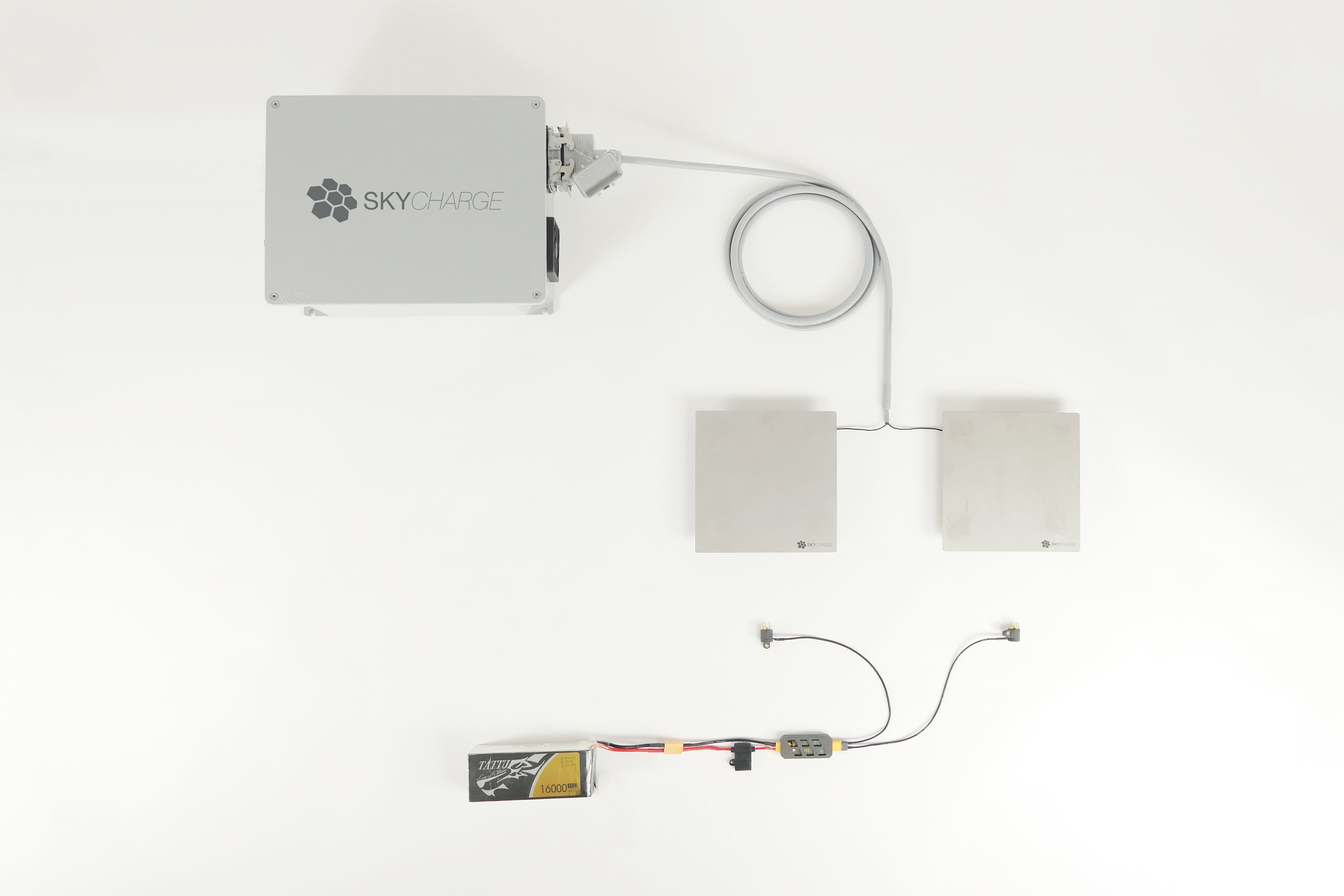User's manual introduction
Welcome to the Skycharge user's manual
The Skycharge system is an automatic and highly programmable charging system. The present user's manual will guide you through how to configure and operate the system.

Skycharge system connected to the contact solution "conductive tiles".
Terms and definitions
Please find below a list of main terms used in this manual.
Term | Description |
|---|---|
Skycharge system | Automatic and programmable charging system comprising a charge source and a charge sink. |
Charge source | Charging electronic assembly responsible for the automatic and programmable power supply. It is installed on the ground and connected to a contact solution. |
Charge sink | Charging electronic assembly responsible for the automatic and programmable power supply. It is installed on the drone/mobile robot and connected to its battery and to the contact unit. |
Charging station | Assembly of Skycharge system, multicore cable, and charging platform. |
Charging platform | Square plated surface, composed of insulated contact tiles, supported by little PVC towers. |
Charging tiles | Two squared conductive surfaces made of steel. |
Multicore cable | Cable to connect the charge source to a contact solution. |
Contact unit | Assembly of parts including spring contacts that is used to establish an electrical contact. It is mounted on the drone/mobile robot and connected to the charge sink. |
Smart battery | LiPo battery with embedded BMS. |
Contact solution | A solution to establish an electrical connection. BOLOGNINI S1 and Contact tiles are two contact solutions developed by Skycharge. |
Warning and safety notes
These warnings and safety notes are particularly important. Please follow the instructions for maximum safety; otherwise the charger and the battery can be damaged or at worst it can cause a fire.
- check that all parts are in good condition before usage;
- check that the charge source, the charge sink, and the contact unit are installed correctly and firmly before usage;
- check the charge system configuration before charging any battery. Configure the system for the type of battery you are charging;
- check the battery voltage. Lithium battery packs can be wired in parallel and in series, i.e. a 2 cell pack can be 3.7V (in parallel) or 7.4V (in series);
- set up adequate current for charging;
- install the system in a controlled environment and use it only in safe conditions;
- all parts must be kept out of the reach of children;
- if provided, make sure the BMS supports your battery;
- the primary potential hazard for the battery is combustion. Protect the battery from extreme heat, extreme cold, puncturing, and flammable surfaces;
- disconnect power from the system before manual intervention;
- do not leave the system unattended during testing.
Voltage misconfigurationIf you are testing the system for the first time and fear misconfigurations, please contact the Skycharge support. During testing procedures, be always ready to disconnect a) the battery from the charge sink and b) the AC power cable from your socket wall. If you have any doubts, please contact the Skycharge support.
Safe deployment siteThe system and the battery should be put on a heat-resistant, non-inflammable, and non-conductive surface. Keep all the inflammable, volatile materials away from the operating area.
Know your batteryMake sure you know the specifications of the battery to be charged to ensure the Skycharge system is properly configured. If the configuration is set up incorrectly, the battery may be damaged. It can cause fire or explosion due to overcharging. The warranty is not valid for any damage or subsequent damage arising as a result of misuse or failure to observe the procedures outlined in this manual.
Battery type | Specifications |
|---|---|
LiPo | Voltage level: 3.7V/cell |
Li-ion | Voltage level: 3.6V/cell |
LiFe | Voltage level: 3.3V/cell |
NiCd/NiMH | NiCd/NiMH |
Pb | Voltage level: 2.0V/cell |
Updated 11 months ago
